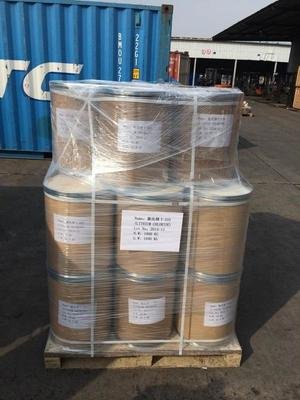a mixture consisting only of lithium chloride
Lithium chloride (LiCl) may seem simple, but it holds significant importance across industries. This white, hygroscopic salt is highly soluble in water, making it ideal for diverse applications. Known for its use in lithium production, moisture control, and even flame colorants, it plays a key role in both industrial and scientific settings. With its unique chemical properties, lithium chloride has become a foundational compound for research, manufacturing, and everyday solutions.
Physical and Chemical Properties of Lithium Chloride
Understanding the physical and chemical properties of lithium chloride (LiCl) is crucial for appreciating its wide range of applications. This section breaks down its appearance, solubility, reactivity, and thermal features.

Appearance and Molecular Data
a white crystalline solid. It can also appear as cubic crystals, granules, or a fine, crystalline powder. This salt is highly hygroscopic, meaning it readily absorbs moisture from the air, often becoming sticky or forming clumps.
From a molecular standpoint:
- Formula: LiCl
- Molecular Weight: Approximately 42.39 g/mol
- Crystalline Form: It has a face-centered cubic lattice structure, similar to sodium chloride.
Its density is around 2.07 g/cm³, which highlights its compact atomic arrangement. For more on its molecular structure, you can refer to Lithium Chloride Molecular Details.
Solubility and Reactivity
Lithium chloride demonstrates exceptional solubility in water, with 67 g dissolving per 100 ml of water at standard temperature. This characteristic makes it valuable in applications like desiccants and chemical reactions requiing lithium ions. Beyond water, it’s also soluble in:
- Ethanol
- Methanol
- Pyridine
- Acetone
Its solubility in organic solvents is more pronounced compared to similar salts like sodium chloride. This sets it apart for use in non-aqueous chemical systems.
In terms of reactivity:
- Lithium chloride reacts mildly with acids but generally functions as a stable and neutral compound.
- In the presence of strong bases, it doesn’t exhibit significant reactivity, underscoring its chemical stability under basic conditions.
Explore its properties further at Lithium Chloride Solubility and Usage.
Thermal Properties
Lithium chloride’s thermal characteristics make it indispensable, especially in high-temperature applications:
- Melting Point: ~605°C (1,121°F)
- Boiling Point: ~1,382°C (2,520°F)
These numbers paint a picture of resilience. For instance, the high melting point allows lithium chloride to be used in molten salt baths for metal heat treatment processes. Its thermal stabiity and salt-like behavior play a big role in industrial and electrochemical fields.
For industrial details on its melting and use at high temperatures, visit American Elements: Lithium Chloride.
By breaking down these key properties, we see how lithium chloride’s unique molecular and physical attributes enable its versatility across industries.
How Lithium Chloride is Produced
Lithium chloride (LiCl) is typically produced through chemical and industrial processes that ensure both efficiency and purity. Its production involves a reaction between lithium hydroxide and hydrochloric acid, followed by refinement processes to achieve the desired quality. Let’s break this down into essential steps:
Reaction with Hydrochloric Acid
One of the primary methods for producing lithium chloride is the neutralization reaction between lithium hydroxide (LiOH) and hydrochloric acid (HCl). This process is straightforward and forms lithium chloride as a byproduct along with water.
- Reaction Formula: LiOH + HCl → LiCl + H₂O
- Step-by-Step Overview:
- Lithium hydroxide, a strong base, reacts with hydrochloric acid, a strong acid.
- These reactants combine to neutralize each other, forming lithium chloride and water.
This reaction is fast and efficient, making it a popular choice for the industrial synthesis of lithium chloride. It’s also an exothermic process, meaning it releases heat. You can learn more about this reaction at Socratic: Neutralization Reaction Details and Lithium Reaction with Hydrochloric Acid.
Purity and Refinement Processes
Once lithium chloride is synthesized, achieving high purity is crucial, especially for applications like batteries, pharmaceuticals, and chemical manufacturing. Contaminants can significantly affect its performance and utiity. The refinement processes often used include:
- Vacuum Crystallization:
Lithium chloride is dissolved in water or another solvent, followed by controlled crystallization. This isolates LiCl while reducing impurities. - Redissolution and Distillation:
High-purity grades are achieved by redissolving lithium chloride in isopropanol or similar solvents. Distilling the solution removes residual moisture and other contaminants. For more insights, refer to this article on Lithium Refining Via Crystallization. - Depressurization:
Advanced methods involve depressurizing and distilling the lithium chloride solution to separate and eliminate impurities effectively. Patented approaches, like the one detailed in High-Purity Anhydrous Lithium Chloride Production, emphasize creating products with over 99.5% purity. - Advanced Technologies:
Companies are leveraging modular solutions to refine LiCl on-site, cutting down costs and improving quality. An example of these methods is detailed at Saltworks Technologies: Lithium Chloride Refinement.
By focusing on these techniques, manufacturers produce lithium chloride that meets the rigorous standards required for various industrial and scientific applications. High-purity lithium chloride not only ensures efficiency but also enhances its performance in specialized tasks.
Conclusion
Lithium chloride stands out as a versatile compound with significant industrial and scientific uses. Its properties, including high solubility and thermal stability, make it invaluable in fields ranging from lithium production to moisture control. It plays an essential role in creating efficient processes and innovative technologies.
This compound’s adaptability ensures its continued relevance across industries, from chemistry labs to large-scale manufacturing. Embracing its potential can drive advancements in sustainable solutions, energy storage, and beyond. Share your thoughts or explore further—lithium chloride has much to offer as innovation progresses.






